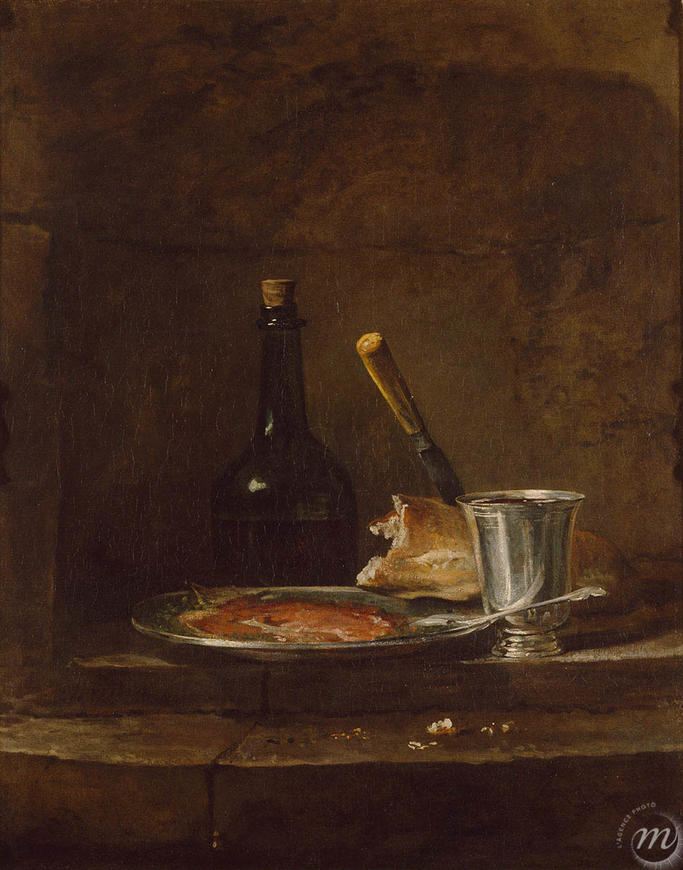Laid out in the pared-down setting of a stone alcove, as if carelessly abandoned by human hand, the objects are in reality methodically arranged. They seem to speak to each other like the protagonists in an intimate family conversation. The knife, projecting out at an angle towards the viewer, is at odds with the tranquillity of the composition's vertical and horizontal lines. The silver goblet belonged to the artist. He delighted in putting it in his paintings throughout his career.
A handful of details draw the gaze: the bread crumbs that have fallen on to the stone edge of the alcove, the reflection of the spoon in the goblet... The brushwork is rich, thick and textured, and the shine visible on the goblet or the edge of the plate is rendered by a few touches of white which scratch the surface of the canvas.
An x-ray of the painting revealed numerous pentimentos: a cabbage and a citrus fruit were in the end painted over to create a plainer composition. The scene is bathed in a soft light and is brought together by a very harmonious colour palette. The atmosphere is silent, almost reverential.
The subject is mundane in itself, but Chardin's rendering of the presence and substance of the objects demands admiration. Austere yet also sensual, the ensemble is dazzlingly realistic. Diderot said of Chardin's still lives: "They are life itself; the objects exist outside the canvas and betray a truth that deceives the eye."
Jean-Baptiste Siméon Chardin was one of the greatest French painters of the 18th century, and specialised in still lives and genre scenes. His paintings of game, fish, fruit and crockery are exquisitely delicate and incredibly lifelike, while his genre works usually portrayed women and children at home, absorbed in everyday tasks. During the last ten years of his life, a degenerative disease gradually robbed him of his sight. He devoted himself to pastel work, with a series of portraits and self-portraits.
Acquired in 1990, with the help of FRAM, the Fonds National du Patrimoine, White Public Relations (Tokyo) and a public subscription
Inv. P 1998

Laid out in the pared-down setting of a stone alcove, as if carelessly abandoned by human hand, the objects are in reality methodically arranged. They seem to speak to each other like the protagonists in an intimate family conversation. The knife, projecting out at an angle towards the viewer, is at odds with the tranquillity of the composition's vertical and horizontal lines. The silver goblet belonged to the artist. He delighted in putting it in his paintings throughout his career.
A handful of details draw the gaze: the bread crumbs that have fallen on to the stone edge of the alcove, the reflection of the spoon in the goblet... The brushwork is rich, thick and textured, and the shine visible on the goblet or the edge of the plate is rendered by a few touches of white which scratch the surface of the canvas.
An x-ray of the painting revealed numerous pentimentos: a cabbage and a citrus fruit were in the end painted over to create a plainer composition. The scene is bathed in a soft light and is brought together by a very harmonious colour palette. The atmosphere is silent, almost reverential.
The subject is mundane in itself, but Chardin's rendering of the presence and substance of the objects demands admiration. Austere yet also sensual, the ensemble is dazzlingly realistic. Diderot said of Chardin's still lives: "They are life itself; the objects exist outside the canvas and betray a truth that deceives the eye."
Jean-Baptiste Siméon Chardin was one of the greatest French painters of the 18th century, and specialised in still lives and genre scenes. His paintings of game, fish, fruit and crockery are exquisitely delicate and incredibly lifelike, while his genre works usually portrayed women and children at home, absorbed in everyday tasks. During the last ten years of his life, a degenerative disease gradually robbed him of his sight. He devoted himself to pastel work, with a series of portraits and self-portraits.
Acquired in 1990, with the help of FRAM, the Fonds National du Patrimoine, White Public Relations (Tokyo) and a public subscription
Inv. P 1998